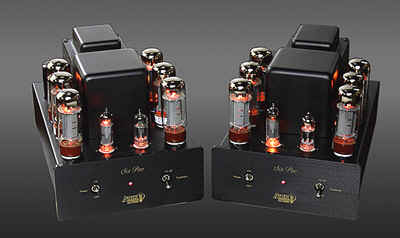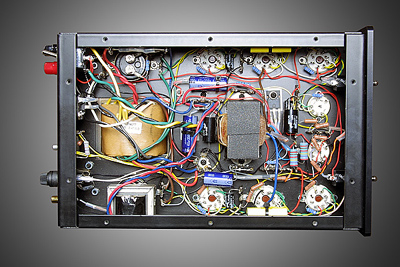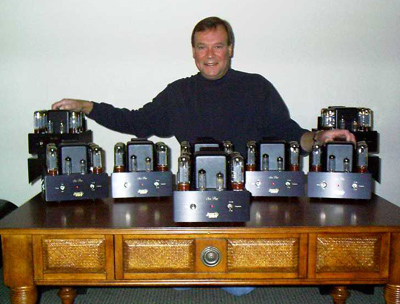|
You are reading the older HTML site
Positive Feedback ISSUE 6 audio electronic supply Sixpac amplifiers as reviewed by Sasha Matson
|
||
|
|
Something's Brewing I thought I was caught up with Dennis Had, as I had finished my review of the wonderful Cary Audio CD308T player, but I got an e-mail from him in which he casually added a P.S.: "I have a new product called Sixpacs, mono tube amps that you will fall in love with. Would you like to do a review?" I don't care if it's a vacuum cleaner attachment—if Dennis designed it, I'm interested. "What are they? Are they done yet?" I fired back. "Triode monoblocks with chutzpah," he responded. "I will send you a pair next week." Done! Refreshing Music In Your Life What are these things, and why are they called Sixpacs? Had credits John Rutan, owner of Audio Connection in Verona, New Jersey with the name, as each amp employs six EL34 output tubes, and is about the size and shape of a six-pack of soda or beer. The Sixpacs are a "choke input" design, configured in push-pull triode, class A/AB. The input tubes are a 12 BZ7 (or 12AX7) input gain/phase inverter and an EL84. The NOS 12BZ7 was a final revision to the design, replacing a 6922 and allowing, in Had's words, for "a much greater swing into the EL34 output tubes with a lower distortion value." He credits Gregg Dunn, national sales manager at Cary, for the final input tube selection. The result is a pair of monoblocks that puts out 50 triode watts at .55% THD. The specs rate noise and hum at 80db below full power. This is some good juice! They retail for $2400 per pair. Each Sixpac weighs a hefty 33 pounds. Had says, "The Sixpac really consists of a lot of iron: the output transformer, a huge power transformer, and the choke. From the front end to the back end, whether you are playing soft, loud, or in between, the voltage does not move." A push-pull parallel design requires serious transformers. As Had puts it, "It becomes critical when you are doing parallel tubes. Impedance lowers when you add more tubes in parallel, and you must have an output transformer that matches that lower impedance. The transformers in the Sixpacs are up to the job of giving a low-distortion output with zero negative feedback." The front panel of each Sixpac is a simple affair, consisting of an on-off switch and a switch that can place 10dB of negative feedback into the circuit. Dennis says, "People are asking me why the heck I put it there. The reason is that I've been a proponent for fourteen years now of either low or zero feedback designs. That switch affords people an opportunity to hear what feedback can do in a negative fashion." He isn't kidding, folks. The change is not subtle—it is a sort of "castration" switch. I demonstrated it for Michael Green (of Room Tune: see the interview in Positive Feedback, Vol. 7, No. 3) and it cracked him up! There is an educational function built into these monoblocks! On the back of each amp is a single RCA input, a switch to select 8 or 4 ohm speaker settings, a knob for biasing (which is very sensitive—you have to tweak the knob a bit to get the bias right), a jack for the included meter cables, and all-American, plastic/metal binding posts, so finger tightening is the way to go. The power cords are detachable, and some will want to swap them out, but they sound just fine.
Sensitivity Training I own a pair of Sonus Faber Concerto speakers. They are rated at about 85dB sensitivity, not that efficient, yet when I popped the pair of Sixpacs into the system, the transformation was unbelievable, not a matter of nibbling at the margins. I had been mulling over whether I wanted to wrestle with subwoofers, but no longer. They are not needed! I have now lived with the Sixpacs for almost two months, so break-in issues have long since been resolved. Since I received one of the first production pairs, I almost qualify as a Beta Tester. Early on, one of the monoblocks produced more in-the-room hum than the other. Sending it back to the "Cary Toy Factory," as Dennis Had sometimes refers to it, the diagnosis was that an element in the choke coating was vibrating. I have been told that this part is now vacuum-sealed to eliminate the problem. The returned monoblock sounds great, and there have been no further technical glitches of any kind from the pair. Kicking Back With a Pair of 'Sixers' At CES in January, I purchased a Classic Records pressing of Ravel's Daphnis & Chloe with Munch and the Boston Symphony. I've played it a number of times with the Sixpacs, and many things catch my ear in this large symphonic/choral work. With the Sixpacs, the wonderful vocalise chorus in the opening and throughout the work was suspended and glowing. The soundstage was wide as all get-out, the string tone rich and full. Brass was authoritative, and startling when appropriate, without a hint of nastiness. The timpani rolls were crisp and articulate. Woodwinds were separated in audio space. There was a nice, visceral "pop" to string pizzicatos, including the driving rhythms generated by the contrabasses as the piece progressed. Terrific cymbal crashes managed to remain integrated in the mix. This is very demanding program material, and the results were outstanding. How about Waltz For Debby by the Bill Evans Trio, via an original 1961 Riverside pressing? Take "My Romance." Scott LaFaro's bass sounded full and round, with plenty of finger-pluckin' tenderness. Paul Motian's drums came across as if I were sitting in the Village Vanguard: terrific hi-hat, killer snare! Evans' piano dynamics were palpable. Pace, rhythm, drive, and vitality were all there. On this recording, the fourth member of the group is the audience. Via the Sixpacs, I could listen in on their conversations if I cared to. I then put on another fine jazz record, Soul Summit, Prestige 7234 from 1962, in an original mint pressing with the cool black and silver Prestige label. The lineup is Gene Ammons and Sonny Stitt on tenor, Jack McDuff on Hammond B3, and Charlie Persip on drums. "Shuffle Twist' by Ammons opens the B side, and it's a great romping blues. The tonal dance between the alternating left- and right-channel solos was ear popping. With the aid of the Sixpacs, McDuff's salty, distorted Hammond B3 sound was very soulful, with those pedals providing the rhythmic oomph down in the basement. The low-end extension produced by the Sixpacs has transformed my listening experience. Kicking it up a notch, I put on a new Classic Records pressing of David Crosby's If I Could Only Remember My Name. I don't usually buy the same stuff over and over, but this pressing replaces an old one that was so scratched that I couldn't listen to it anymore. "What Are Their Names," which opens the B side, has never sounded more politically timely, and it was just plain good sounding, too. It's basically a jam that builds to a quick head. I could instantly detect the sound of Phil Lesh's bass and Jerry Garcia's guitar at the start of the piece. Lesh has always gotten such a fine sound, a great combination of highs and lows. The group vocal gave me a thrill, as Grace Slick's inimitable wail rose out of the mix. This cut makes a nice contrast to the next, "Traction In the Rain," a lovely, delicate Crosby number highlighting plucked acoustic instruments, like dulcimer. Crosby's vocal? Man, that guy has a voice! The acoustic guitars were right there, and Joni Mitchell was hovering in the ether of the background. Lovely stuff, indeed, and beautifully transmitted by the Sixpacs. Solid state guys often think that tube guys are making everything sound warm and fuzzy, so I decided to pick a couple of the worst recordings I own and see if they still sounded bad! First up in the garbage in/garbage out test was a Philips Digital Classic set of Beethoven's Piano Concertos, recorded live in 1983 (the dawn of the digital age) by Alfred Brendel, James Levine, and the Chicago Symphony. Great musicians of course, but what a HORRIBLE string sound. You could grate coleslaw with it. The brass sounds equally nightmarish at every climax, and the cellos sound like a hive of wasps on the prowl! With the Sixpacs, it was all there, as awful as I remembered it. Another CD I've disliked for some time is an early digital issue from Billie Holiday's Columbia catalog. Every tune is so rolled off that Billie sounds like she's been chugging cough suppressant. I compared this to the exemplary 2001 Columbia/Legacy Lady Day—The Complete Billie Holiday. Thank you, Columbia, for righting a terrible wrong, and one of the finest historical recording restorations ever. The winner? The original 78s, played on my 1917 Victor Model IV. There's something about hearing Billie right there next to you, totally analog, as in hand-cranked. I'm happy to say that at the conclusion of this listening test, I threw the earlier CD into the garbage. That felt good! Can the Sixpacs rock, you ask? You betcha, as verified by putting on my original pressing of the Stones' Exile On Main Street, to me the single greatest Stones record and one of the very few all-time top pop records. Take "Soul Survivor." Charlie Watts is kicking that bass drum like only he can. Keith's power strums? Yeah baby, yeah! And Mick is loud, clear, and in your face. The point at which the band falls in again after the break has got to be one of the great moments in rock. Or, how about "Loving Cup," one of the most sensually erotic of all rock songs? Charlie Watts and Bill Wyman come on like a ten-ton Mac truck courtesy of the Sixpacs. The vamp at the end of the tune boogies like a pack of hookers moving down Main Street! Talking With the Brewmaster After I'd had the pleasure of living with the Sixpacs for a number of weeks I conversed with Dennis Had briefly about aspects of his design. Here is a transcript of some of our conversation: Sasha Matson Your comments on 'choke-input' designs? Dennis Had In essence what is occurring is whether you play the amplifier loud or soft, the power supply does not change. The voltage is steady. S.M. What Cary or Audio Electronic Supply products are the Sixpacs most similar to? D.H. What is nice about having the opportunity to have a company like AES is that I do a lot of my experimenting that way. One of the major experiments with AES was the Superamp. The Superamp then became the Cary V12, which also became the Cary Rocket 88, this is the same type of circuitry. Then I proceeded to work on this Sixpac. Then once again the AES becomes Cary in the form of the V12R and the Rocket 88R Version which we are just starting to ship now. It was embarrassing; I had to make a change to the Carys after the Sixpacs! I'm going to go back and give the Superamp a bit of that flavor as well. S.M. Can you describe the sonic presentation of the Sixpacs? D.H. I think what they do more than anything else is add a foundation to the music. A tremendous amount of weight – not to be confused with the term "bass." The foundation of the music is so firm, the weight of the symphonic presentation. We have that 'you are there' weight factor, if I can use that term. S.M. Meat on the bones? D.H. That's it! S.M. Comment on speaker sensitivity in various design choices. D.H. It really has to do with the amplifier's ability in complex passages, covering in essence the entire human audibility spectrum, for the amplifier to maintain its composure, and at the same time keep a constant current available to handle the loudspeaker. S.M. How do you decide on the optimum bias setting? D.H. The test jockeys would probably say they would like to have the Sixpac bias run at 280 milliamps, because that is the absolute best test specs. 210 to 230 milliamps is the preference of my ear, and still has stellar test results. S.M. Who are the Sixpacs intended for? D.H. The way I view it is this is to give people the flavor of Cary Audio in a less exotic, more plain-Jane Chevrolet-type of a presentation. I would like the Sixpac to be an entré for people into vacuum tubes. The feedback from customers has been extraordinary; this is a product that has put a big smile on my face!
Historical Conclusions Audio Electronic Supply is a wholly owned subsidiary company of Cary Audio Design, begun in 1994 to provide direct sales of components, parts, and high-end kits. They can be contacted at the address information included below. AES has a number of fine products in their current catalogue, including the great-sounding and attractively priced tubed phono stage, the PH-1, (available as a kit or assembled), which is my current reference. Before long Dennis and company may tire of all the six-pack related metaphors, but for myself and Homer Simpson this is a soothing image. Then again, my wife tells me that a Sixpac is something which men who are buff have. You decide. I may be among the first, but somehow I don't think I'm going to be the last, to say something like the following: Dennis Had has designed and created a new classic in the Audio Electronic Supply Sixpac monoblock amplifiers. They are worthy of comparison to his finest designs for Cary Audio and AES, as well as premier examples by many other high-end companies. The Audio Electronic Supply Sixpacs are an amazing value; you do the math! I have not heard anything that comes even remotely close to these amplifiers in their outstanding bang-for-the-buck and pure musical happiness quotients. Once in awhile you get the feeling that something is just plain right- well these Sixpacs are. As I mentioned, those with undernourished speaker systems will benefit, but so also will a wide variety of listeners. The music made by the Sixpacs contains that magical elusive factor I associate with the live concert experience. It is not a matter of playing louder; these amplifiers sound marvelous at any listening level. The music seems alive and fully formed, with body and heft that appear lifelike and fluid, rather than containing any tube artifacts or over-emphasized frequency ranges. These amplifiers play flat throughout the harmonic spectrum without being overly analytical or lifeless. If it's on your recordings and making it through the rest of the reproduction chain, you are going to hear it loud and clear. These are the little amps that can. I am most pleased to help spread the good news. Well done Dennis- the next round is on me! Sasha Matson Audio Electronic Supply "Sixpac" triode monoblock amplifiers. Cary Audio Design
|



